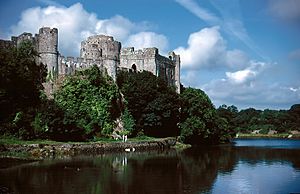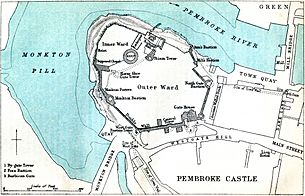Siege of Pembroke facts for kids
Quick facts for kids Siege of Pembroke |
|||||||
|---|---|---|---|---|---|---|---|
| Part of the Second English Civil War | |||||||
 The Northwest side of Pembroke Castle |
|||||||
|
|||||||
| Belligerents | |||||||
| Commanders and leaders | |||||||
| Gen. R. Laugharne Col. Rice Powell Col. John Poyer |
Oliver Cromwell | ||||||
| Casualties and losses | |||||||
| 30+ killed | Unknown | ||||||
The Siege of Pembroke was an important event in 1648 during the Second English Civil War. During this time, soldiers who supported the Parliament (called Parliamentarians) fought against those who supported the King (called Royalists). In this battle, Parliamentarian troops led by Oliver Cromwell surrounded and attacked Pembroke Castle in Wales. The castle had become a safe place for some Parliamentarian soldiers who had rebelled after the First English Civil War ended.
Why the Siege Happened
In April 1648, some Parliamentarian soldiers in Wales had not been paid for a long time. This made them very unhappy. They decided to rebel and support the King's side. Their leader was Colonel John Poyer, who was the Parliamentarian Governor of Pembroke Castle.
He was joined by Major-General Rowland Laugharne, who was his commander in the area, and Colonel Rice Powell. Laugharne tried to attack a smaller Parliamentarian army led by Colonel Thomas Horton at the Battle of St. Fagans. However, Laugharne's attack failed. He then took what was left of his army to join Colonel Poyer at Pembroke Castle.
Getting Ready for the Siege
Colonel Horton marched his 3,000 well-trained soldiers, many of whom were dragoons (soldiers who rode horses but fought on foot), west to Tenby. He then began to surround Tenby Castle. About 500 Royalist soldiers, led by Colonel Rice Powell, were defending Tenby Castle.
Meanwhile, Oliver Cromwell was leading another Parliamentarian army. His army had three groups of foot soldiers and two groups of horse soldiers. He reached Gloucester on the same day Laugharne's army was defeated at the Battle of St. Fagans. Cromwell then crossed into South Wales soon after.
He left Colonel Isaac Ewer with a small group of soldiers to surround Chepstow Castle. This castle was defended by Sir Nicholas Kemeys. Cromwell then continued his march to join Horton at Tenby, arriving on May 15. He left Horton with enough soldiers to deal with Powell at Tenby. Cromwell then took the rest of his army to begin the siege of Pembroke Castle.
Kemeys was killed when Chepstow Castle was attacked on May 25. Powell was captured when he surrendered Tenby Castle to Horton on May 31. But Pembroke Castle was a very strong old fortress. It could not be captured quickly. The castle stood on a rocky piece of land that was surrounded by the sea on three sides. On the land side, its defenses included a deep ditch and walls that were up to 20 feet (6.1 m) thick.
The Siege Begins
Ships carrying large siege cannons for Cromwell were pushed back up the Bristol Channel to Gloucester by strong storms. Because of this, Cromwell tried to attack the castle directly from the front. This attack failed because the ladders his soldiers used to climb the walls were too short.
The defenders inside the castle managed to surprise Cromwell's soldiers with a sudden attack. They killed thirty of the attacking soldiers and damaged the walls Cromwell's army had built around the castle. The large siege cannons finally arrived in mid-June. However, for the next month, they did not cause much damage to the castle's thick outer walls.
Eventually, the siege ended when Cromwell's forces found the secret pipe that brought water into the castle. They cut off the water supply to the defenders. Without water, Poyer and Laugharne were forced to give up on July 11.
After the castle was captured, Cromwell ordered it to be damaged so badly that it could never be used as a military fortress again. Laugharne, Poyer, and Powell were taken to London. They were put on trial and sentenced to a serious punishment. However, Poyer was the only one to face the most severe consequence, decided by drawing lots, on April 25, 1649.


